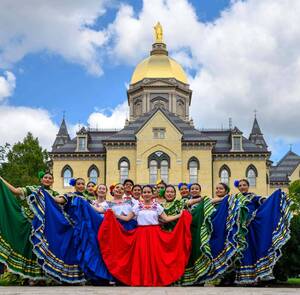 "
"
I still remember talking with my dad the night before leaving for my first semester at Notre Dame. We shared stories back and forth on the living room couch, from recollections of early morning car rides to long winded road trips visiting family. Like the emotional man he is, he could not help but cry at the recollection of so many memories, and I followed suit. Wiping the tears from his eyes, he began to chuckle, before lightening the mood:
“You’re gonna be the only Mexican kid up at that school!”
I could not help but laugh at his words. I knew a school like Notre Dame would not be the hub of Hispanic students I was accustomed to at home. Nevertheless, I set forth on my journey with optimism and a desire to meet students from various backgrounds during my time in South Bend. Since then, my education at Notre Dame has expanded beyond the classroom, teaching me about the broad scope of the Latino community and what it means to be a part of it.
Growing up in San Antonio, Texas, I was familiar with the term “Latino.” However, residing in a city with a majority population that comes from Mexican descent altered my understanding of the word. While I knew that the term represented people with Latin American origins, it was difficult to comprehend that the term referred to more than Mexicans. It was only when I arrived in South Bend, the most predominantly white community I had been a part of, that I began to see the wider scope of the Latino community.
The first Latinx Student Alliance (LSA) meeting my freshman year is where I began to see my understanding of the Latino community shift. As the student officers introduced themselves and the various cultural groups present on campus, I realized there was much more to the Latino community than Mexicans. In that moment, I became aware of and got to know students of various Latino backgrounds: Guatemalan students, Venezuelan students, Dominican students. No longer was I one of many “Mexican” students but one of many Latino students.
Starting my education at Notre Dame not only taught me about the array of identities and cultures encompassed by the Latino community, but also elements of the Mexican identity that were less familiar to me. Throughout much of my time in school and playing sports in San Antonio, I was surrounded by friends of Mexican descent. However, all of us had a family history within the United States, making us either second or third generation Americans. When I got to Notre Dame, I was met with students from different backgrounds, many of whom were first generation Americans or college students. While I was not surprised by the volume of students with this background, it did offer a new perspective. My college friends and I, though we had similar ethnic backgrounds, had different journeys leading to life at Notre Dame. We had varying challenges in high school, varying relationships with friends and even varying experiences among family. It was this realization that made me reflect on the ways that my family supported me: late-night flashcard reviews with mom, math examples with dad. It was learning about these different experiences that taught me the complexity within the Latino identity, even within the various cultures it represents.
I never expected to learn so much about the Latino identity and so much about my own background while traveling thousands of miles away from home. Yet, every time I return home from campus, I feel I have a greater understanding of the world around me. As Hispanic Heritage Month comes to an end, it is these experiences that give me a greater appreciation of the vastness that makes up this community. There is not one identity, one lifestyle, that defines a Latino. Each individual has their own story, their own experiences, and it is that diversity and uniqueness that makes the community special.